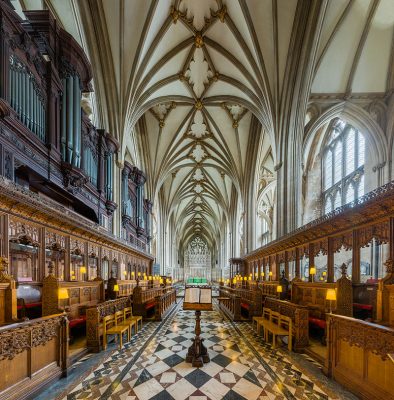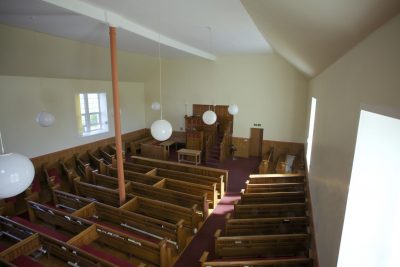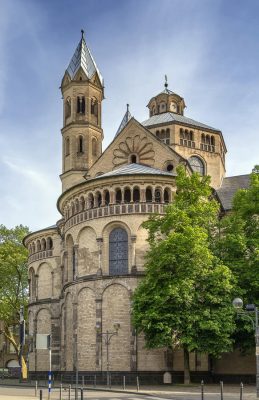
Bristol Cathedral
For Horace Bushnell, spending a year abroad in Europe meant taking a big leap of faith. Arriving solo in the summer of 1845, the Connecticut clergyman used travel to evolve some of his best-known beliefs. His first stop was Exeter Castle, then Bushnell hurried on to service at Bristol Cathedral. The self-proclaimed “Yankee parson” was dazzled. Grand organ music soared up to stir the church’s 12th-century bones. Starburst-shaped tomb recesses, stocked with medieval effigies, bordered the pews. In the choir, more fantastic scenes of mermaids and medieval sports made the woodwork gleam and jump to the eye. From every angle, new details stung his view. The whole mass was, he wrote, “enough to make an American feel all over.” But the morning after was something different. When Bushnell reflected on his first English mass, he felt hollow. The service was gilded with Christian trappings, he thought, but held little true devotion at its core. “I came away, and brought on here with me a cathedral,” Horace Bushnell wrote. “But somehow I lost it in the night, and do not find myself any better Christian this morning.”
Moving onward through Oxford and Coventry, he indulged in a some genealogical research of his wife’s family, the Davenports. Then he pressed on to Glasgow by steamer. None of his promised contacts were available to see in the city. “Sick at heart at forever being a stranger,” Bushnell ventured deeper into the Scottish Highlands. There, far from the Congregationalist cocoon of Hartford, he found himself on surprisingly familiar religious ground. In his journal, Bushnell related a happy Sunday spent praying alongside several shepherds and their families at the Scottish Free Church at Tarbert. Bushnell marveled at the church’s spare simplicity and the “laborious prayer” that focused on the Psalms. He admired the “plain, homespun” sincerity of his fellow believers. And he praised the minister’s nearly two-hour sermon, in which “the Bible was beaten severely…and yet it was no pantomime.” Bushnell felt like he was “carried straight back to the time of the Covenanters.” There was a purity and a piety to the scene that fused, vividly, with that of his own flock an ocean away. And with this new worldliness came criticism, as a more cosmopolitan Christianity began to take root in Bushnell’s mind.

Scottish Free Church at Tarbert
After brief tours of Edinburgh and London, Horace Bushnell embarked for the Continent. He was captivated by the work of Johannes Ronge and Johannes Czerski, two reformers then at their peak as leaders of Germany’s New Catholic movement. Ronge and Czerski led services in German, favored dismantling Roman hierarchy, and set forth a New Testament-based theology. Bushnell appreciated the spiritual vigor of what he labeled the “new Reformation,” if not the “delusional” priests at its head; in order for Germans to unite in overhauling the church, he wrote, “a Luther is wanting.” As he traveled, Bushnell took notes on his European counterparts’ theology and rhetoric. At Geneva, he remarked on the coarseness of the current minister in John Calvin’s pulpit. He commented on how “thinly sprinkled” the laity in were in the cathedral’s pews, “scarcely more than half as large as my own at Hartford.” Services in Antwerp did little to heal the same “soul-sickness” he suffered in England. Choking on incense, he tried to commune with God among the “magnificent churches or cathedrals and the profligate-looking priests.” With difficulty, Bushnell managed to “extract, by a little spiritual alchemy, the food of worship, to bring into play some great, and powerful, and, I trust good emotions.”
Ready to engage with a wider world of religion, Bushnell triggered mixed reactions among the European clergy. In Geneva he spoke with César Malan, a conservative French evangelical and noted hymn writer, who met Bushnell’s pitch for Christian union with a resounding no. Bushnell thought that Malan was “jealous, too, of having Christians mix up with worldly principles, of talking about the progress of society.” Malan’s aversion to the Christian Alliance, largely prompted by efforts to wipe out Catholicism in Italy, was shared by a prominent ring of Swiss clerics—all discouraging news for Bushnell’s campaign. Their dialogue, however, continued. For Malan and other clergymen, Bushnell personified American religion and was therefore accountable for its limits. Malan claimed that Americans were overly cosmopolitan when it came to faith. He charged that American believers had grown shiftless, irresponsible, and unorthodox—overall, they were a little too flexible at refitting theology for the sake of convenience. “If I could speak to the churches in America,” Malan told Bushnell, “I would tell them that their speeches are too worldly, too much worldly policy, too little of Christ.”

The Basilica of the Holy Apostles, Cologne
There were brighter moments on Bushnell’s religious tour. In Cologne he admired the “Byzantine stamp” of church architecture, observing that it echoed a “mould well adapted to Puritan churches in America.” He looked for clues that Providence guided other cultures. Uable to speak French of German, Bishnell relied (literally) on communicating through signs of grace. As the trip progressed, any concern over his lack of fluency faded. Christianity became Bushnell’s cultural shorthand for all human experience. Watching Swiss emigrants depart Lake Zurich, bound for the United States, he was moved “to see these people, living in the most beautiful scenery of the world, turning their eyes and their longing footsteps towards America; but sweeter than all, to distinguish among the parting words—Jesus Christ; for that bespoke a better country for all.”
Bushnell and a fleet of antebellum ministers taught that a godly home bred good citizens. So what did the young republic look like from afar? When he examined America through the lens of European travel, Bushnell described an “organic” society with a spirit “more or less favorable to religious character, and, to some extent at least, sovereign over the individual man.” This sense of shared morality extended past the household, governing church, state, family, and school as one “divine organism.” In Christian Nurture (1847) and elsewhere, Bushnell advised that skillful parenting meant embedding the Christian values needed to withstand the forces of national progress. He applied that principle to any community, the world over, as all of Calvin’s heirs were fair game for improvement. As he practiced old and new forms of faith in cities he once read about, the through lines of Bushnell’s thought colaesced: heartfelt worship eclipsed orthodoxy; supernatural and natural elements coexisted in man; and religious liberties needed protection. Ideas in hand, the newly minted adventurer consulted his intinerary. A trip to Ireland, Bushnell wrote, would be “anti-climactic, after seeing the greatest wonders of the civilized world,” and French churches were “dirty” with irreligion. The Yankee parson turned to Rome.
Next: The Preacher and the Pope

One Thought on this Post
S-USIH Comment Policy
We ask that those who participate in the discussions generated in the Comments section do so with the same decorum as they would in any other academic setting or context. Since the USIH bloggers write under our real names, we would prefer that our commenters also identify themselves by their real name. As our primary goal is to stimulate and engage in fruitful and productive discussion, ad hominem attacks (personal or professional), unnecessary insults, and/or mean-spiritedness have no place in the USIH Blog’s Comments section. Therefore, we reserve the right to remove any comments that contain any of the above and/or are not intended to further the discussion of the topic of the post. We welcome suggestions for corrections to any of our posts. As the official blog of the Society of US Intellectual History, we hope to foster a diverse community of scholars and readers who engage with one another in discussions of US intellectual history, broadly understood.
Thanks so much for this post, Sara! I’ll say more about this when we get to blogging about Volume II of the Hollinger & Capper collection, but one of the things that I enjoy about teaching Volume I is that I am relatively unburdened by broader knowledge of the period (though of course, blessedly more burdened than my students are). When I teach Volume II, in a sense I know too much about the authors and about other authors and texts that didn’t make the cut. This can make focusing on the texts at hand more difficult, in part because it is harder for me to understand how my students are likely encountering the texts. Of course, the flip side of this is that I know less about folks like Bushnell than I ought to. So posts like this are not only fascinating to me, but really helpful, too.